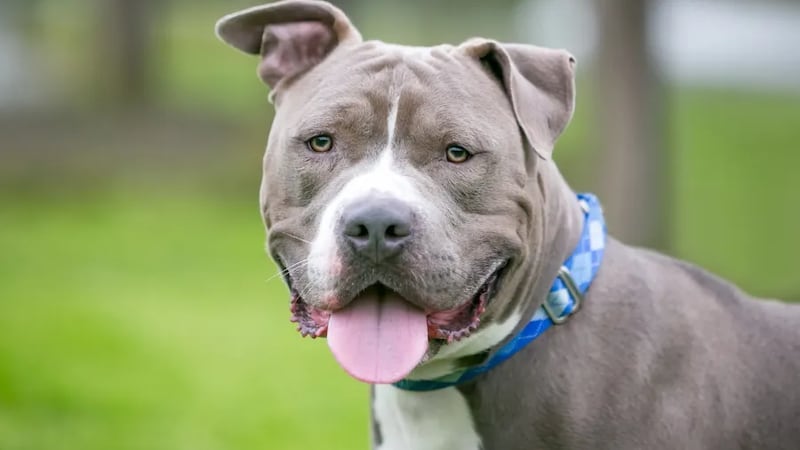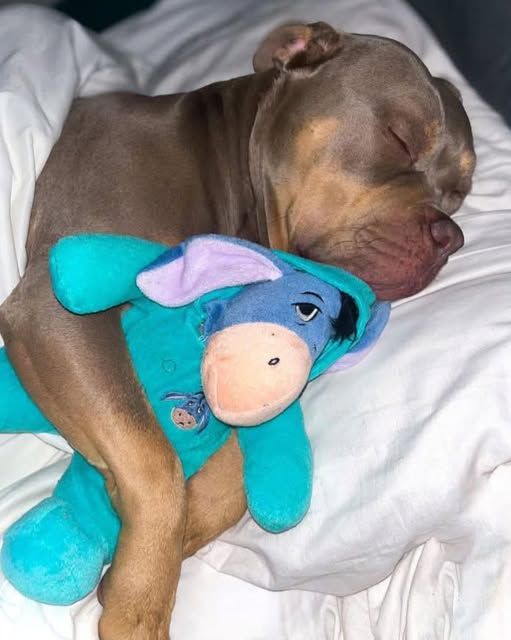The Dog with the Blue Blanket
He slept like this for weeks — curled up in a cold metal box, behind bars, his only comfort an old blue blanket. No one really knew where he had come from, nor how long he had been waiting. But everyone at the shelter knew one thing: he never let go of that blanket.
It was chewed, frayed, and covered in paw prints — yet to him, it was everything. When he trembled from fear, he wrapped it between his legs. When loud noises echoed through the kennels, he buried his head beneath it. And whenever footsteps passed by his cage, he looked up, the blanket still close, his eyes quietly saying, “I’m still here. Please don’t forget me.”
Volunteers noticed his expression — a mix of sadness and patience, the kind seen in those who have known loss but refuse to give up hope. Every night, he was found the same way: lying in the corner, holding his blanket like a child clinging to a memory.
The Moment That Changed Everything
One morning, a visitor walked slowly down the shelter corridor. Dogs barked, tails wagged, but the blue-blanket dog stayed still. He didn’t rush to the bars or beg for attention. He simply sat, wrapping his paws around his blanket, his eyes soft but tired.
For a moment, the visitor stopped in front of his cage. Just one look — no words, no gestures — and then moved on. But something had shifted. That brief glance was enough to spark connection. A few hours later, the same person returned with adoption papers.
When the gate finally opened, the dog hesitated. It was the first time in a long time he had walked out without fear. His paws trembled, his heart raced, and his blanket hung gently between his teeth.

The First Ride Home
In the car, he refused to let go of his blanket. He held it close the entire drive, pressing his nose into its worn fabric as if to reassure himself that everything was real. The wind carried new scents — grass, rain, freedom — but the blanket was still his anchor, a bridge between the life he had survived and the one waiting for him.
When they arrived at his new home, he found a soft bed waiting. He didn’t explore right away. Instead, he did what he had always done — laid down, rested his head on his blue blanket, and finally, for the first time, slept peacefully.
Learning to Feel Safe Again
In the weeks that followed, he began to change. The once-nervous dog who hid from every sound now wagged his tail when the door opened. He learned that footsteps no longer meant fear, but friends. That gentle hands brought food, warmth, and affection.
He carried his blanket from room to room — not out of fear anymore, but out of comfort. It became a symbol of how far he had come. When he curled up beside his new family at night, the blanket lay next to him, no longer a shield, but a keepsake of resilience.
The Symbolism of the Blue Blanket
For his new family, that old blue blanket became more than a piece of fabric. It was a story — one woven with courage, patience, and hope. Though torn and faded, it represented survival.
Every hole in the blanket told a story: of nights spent waiting, of the loneliness he endured, and of the strength it took to keep believing that one day, someone would see him.
Psychologists who study animal behavior and attachment often describe how rescue animals form deep emotional connections with familiar objects. These “transitional items” act as emotional anchors, providing comfort in unfamiliar environments — much like a child’s favorite toy or blanket. For shelter dogs, they symbolize safety and stability amid constant change.
Jake’s blue blanket (as his family later named him) was exactly that — his bridge from past to present, from survival to peace.
A Universal Story of Hope
His story mirrors countless others in shelters around the world — animals waiting for a second chance, for someone to see beyond their scars. In every rescue center, there are dogs like him: quiet, patient, holding on to hope in their own small ways.
Volunteers often say that these dogs are the most grateful adoptees. They seem to understand what it means to be saved. Their loyalty runs deep, and their joy in finding a home is pure and unguarded.
Jake’s story reminds us that compassion doesn’t need to be grand or dramatic. Sometimes, it’s as simple as stopping for a moment, meeting a pair of hopeful eyes, and saying, “You’re not forgotten.”

Scientific Insights: The Healing Power of Love and Routine
Animal welfare research shows that love and routine can transform even the most traumatized rescue dogs. Studies from the American Society for the Prevention of Cruelty to Animals (ASPCA) and Cornell University’s College of Veterinary Medicine highlight that consistent care, calm environments, and gentle touch help animals rebuild trust and reduce anxiety.
Neuroscience explains that affectionate interaction triggers oxytocin release — the same “bonding hormone” responsible for emotional connection in humans. Over time, this biological response allows rescued animals to replace fear with attachment, transforming survival behavior into genuine affection.
Jake’s newfound peace wasn’t just emotional — it was biological. His brain, once wired for stress and alertness, began to associate people with safety and comfort. The old blue blanket remained part of that healing process — a tangible link to security and continuity.
Cultural Reflections: Objects That Carry Memory
Across cultures, objects often serve as symbols of endurance and emotional continuity. In literature and art, a worn keepsake — a toy, a letter, a blanket — represents not material value but the strength of memory and love.
Jake’s blanket carries the same meaning. It reminds us that love can reside in the simplest things, that memory is not weakness but a sign of resilience. For Jake, it was not about holding on to the past — it was about acknowledging it while embracing the present.
In a broader sense, his story reflects the human–animal bond that has shaped civilizations for millennia. From ancient times, humans have shared their homes and hearts with animals, forming relationships built on trust and mutual care. Modern science now validates what humanity has always felt — that these bonds enrich both sides, fostering emotional growth and wellbeing.
The Day the Blanket Lost Its Fear
Today, Jake still sleeps with his old blue blanket. But the meaning has changed. He no longer clutches it in trembling paws. Now, he holds it gently, out of tenderness — a quiet acknowledgment of how far he has come.
He sleeps peacefully in a warm bed, surrounded by the love he once only dreamed of. His family often finds him resting his head on that same blanket, eyes closed, his expression serene — as if he’s saying thank you.
Thank you to the volunteers who cared when no one else did.
Thank you to the person who stopped, even for just a moment, and saw him.
Thank you to those who believe that every life, no matter how small or scarred, deserves a chance.
The blanket, old and tattered, has no value to anyone else. But to Jake, it’s priceless — a reminder of survival, love, and the invisible thread that kept him alive through the darkest nights.
Reflection: What Jake’s Story Teaches Us
Jake’s story is not just about a rescued dog. It’s about faith — the kind that endures when everything else fades. It’s about patience and compassion, the quiet strength found in waiting and believing.
His blue blanket is a simple object, yet it holds a lesson for us all: that sometimes, hope survives in the smallest gestures — a soft touch, a kind word, a moment of empathy.
In a world often rushing past, Jake’s journey reminds us to pause, to notice, and to care. Because sometimes, the difference between despair and joy is just one person who decides to stop — and see.
And so, every night, as Jake curls up with his beloved blanket, his heart at peace, it’s as if he whispers through his dreams:
“I waited a long time… but now, I’m home.” ❤️🐾
Sources
-
American Society for the Prevention of Cruelty to Animals (ASPCA). Shelter Dog Recovery and Emotional Resilience Studies. aspca.org
-
Cornell University College of Veterinary Medicine. Canine Behavior and Rehabilitation Research. vet.cornell.edu
-
National Institutes of Health (NIH). The Neurobiology of the Human–Animal Bond. nih.gov
-
American Veterinary Medical Association (AVMA). The Role of Comfort Objects in Animal Welfare. avma.org
-
Psychology Today. “How Dogs Heal from Trauma and Build Trust Again.” psychologytoday.com
